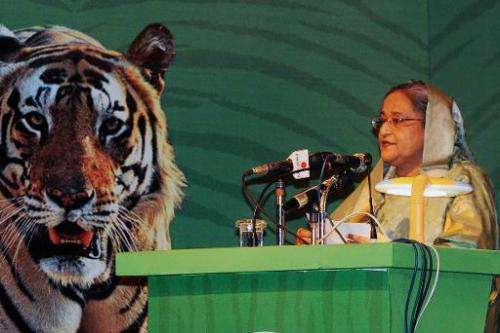Bangladesh meet begins to save endangered tigers

Some 140 tiger experts and government officials from 20 countries met in the Bangladeshi capital Dhaka on Sunday to review progress towards an ambitious goal of doubling their number in the wild by 2022.
The nations, including the 13 where tigers are still found in the wild, had vowed at a landmark meeting in 2010 in the Russian city of St Petersburg to double the population of critically endangered wild tigers.
Experts say the number declined to as few as 3,200 in 2010 from 100,000 only a century ago. But since then, poaching has reached critical levels and has emerged as the greatest threat to wild tigers.
Statistics from TRAFFIC, the wildlife trade monitoring network, show that a minimum of 1,590 tigers were seized between January 2000 and April 2014. That represents an average of two per week.
Officials, however, listed some progress in the four years since the St Petersburg summit, including a rise in the wild tiger population in major "tiger range" nations—countries where the big cats are found in the wild.
"There has been some increase in the number of tigers in significant countries such as India, Nepal and Russia," said Andrey Kushlin, programme manager of the Global Tiger Initiative.
Bangladesh Prime Minister Sheikh Hasina opened the conference, saying efforts to conserve the wild cats have reached a "turning point".
But her own government has been under fire from experts at home and abroad for setting up a giant coal-fired power plant on the edge of the Sundarbans mangrove forests, home to one of the largest tiger populations.

Local experts fear the 1,320-megawatt power plant now being built will pollute the water of the world's largest mangrove forest, jeopardising its delicate biodiversity and threatening the tiger population.
Bangladesh says some 440 Bengal tigers live in its part of the Sundarbans—a figure disputed by local experts who say the number will be less than 200.
Kushlin said at the conference the 13 range nations are expected to agree by 2016 to provide an accurate census of their wild tiger populations.
"We need accurate figures so that we know where we stand," said Kushlin, who also works for the World Bank.

The 13 tiger range countries are: Bangladesh, Bhutan, China, Cambodia, India, Indonesia, Laos, Malaysia, Myanmar, Nepal, Russia, Thailand and Vietnam.
The International Union for the Conservation of Nature has listed the tiger as critically endangered. Poaching, encroachment on its habitat and the illegal wildlife trade are blamed for the declining number.
The conference will end Tuesday with the adoption of a Dhaka Declaration, which will set actions for the remaining eight years of the goal.
© 2014 AFP
















